
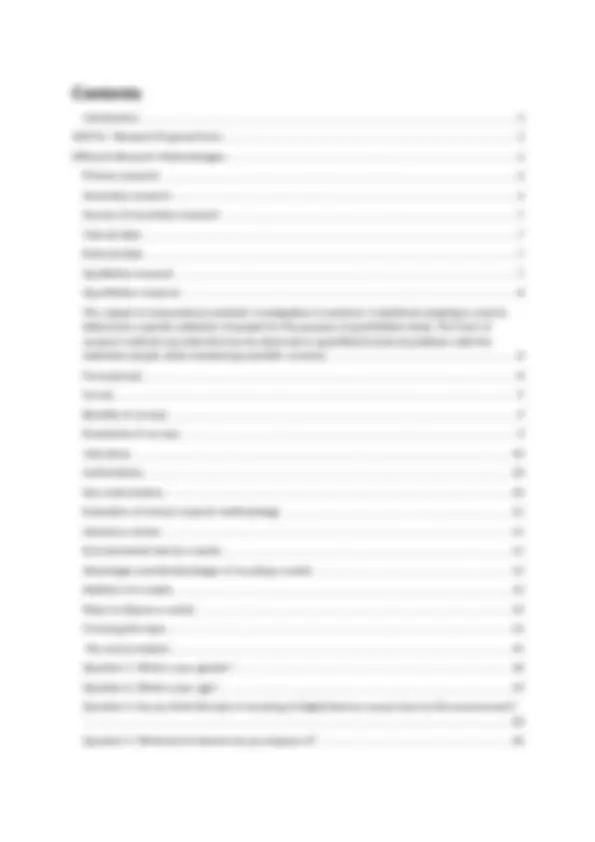
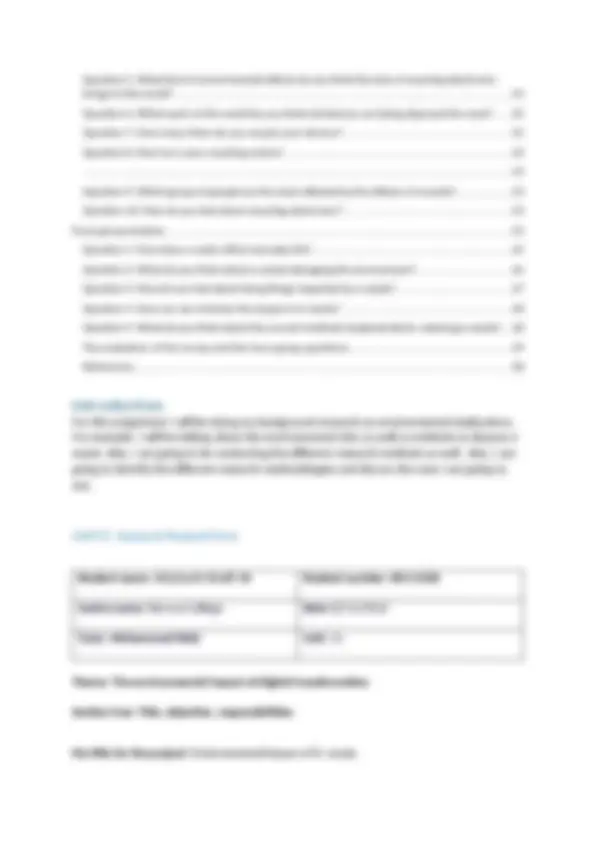

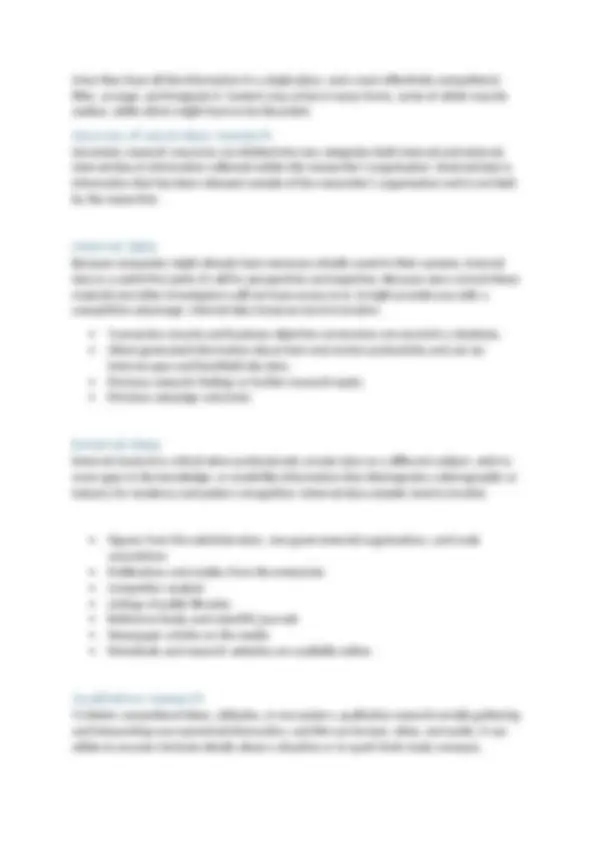
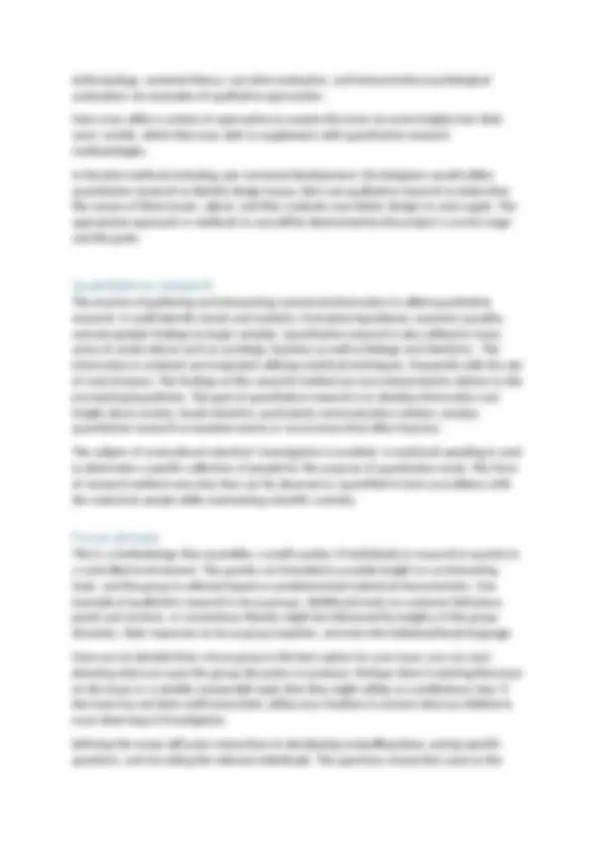
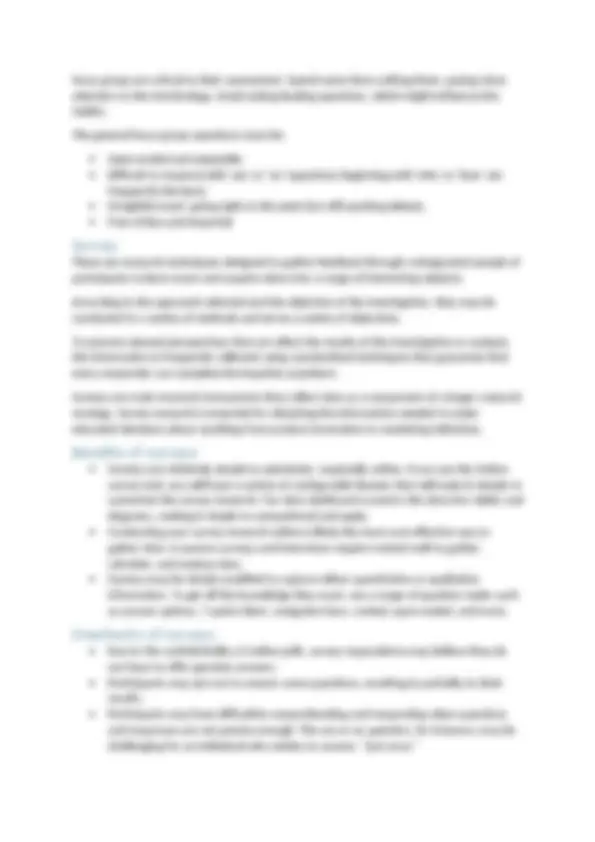
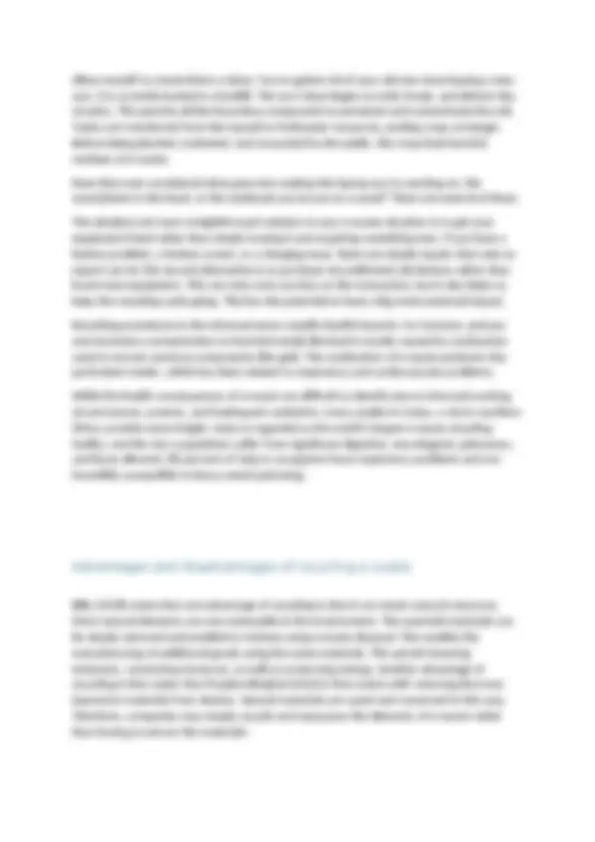
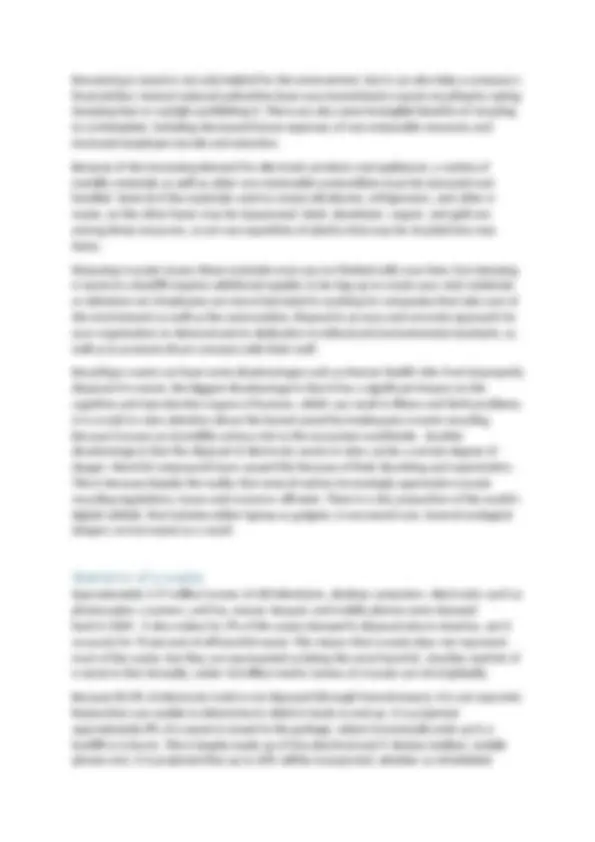
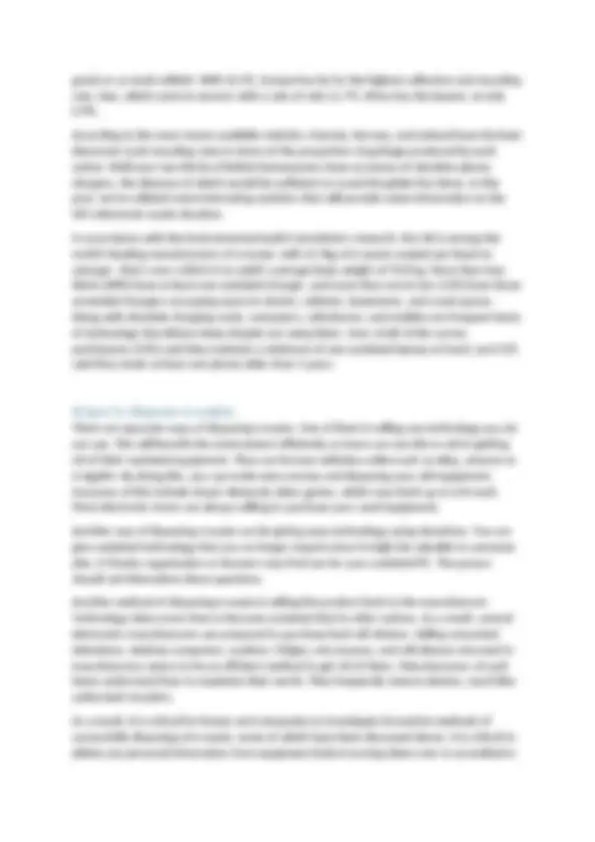
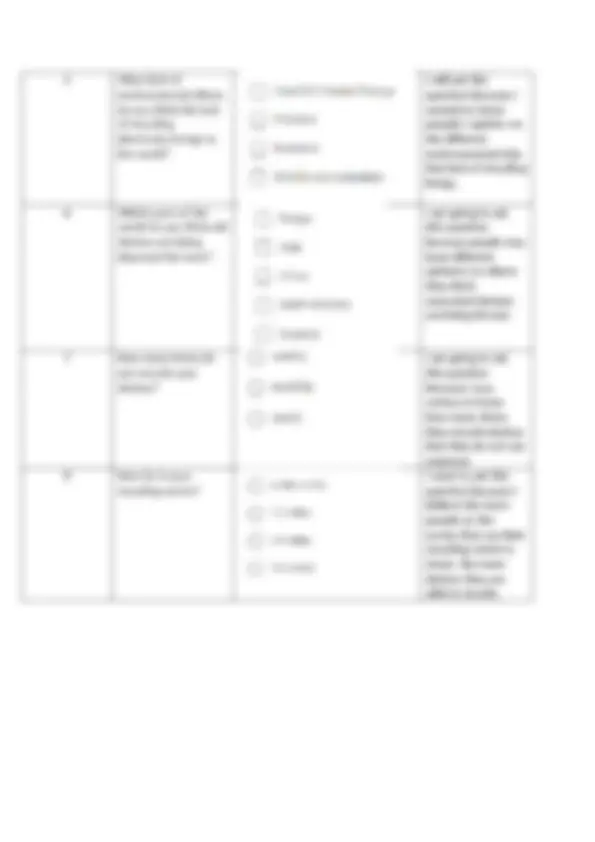

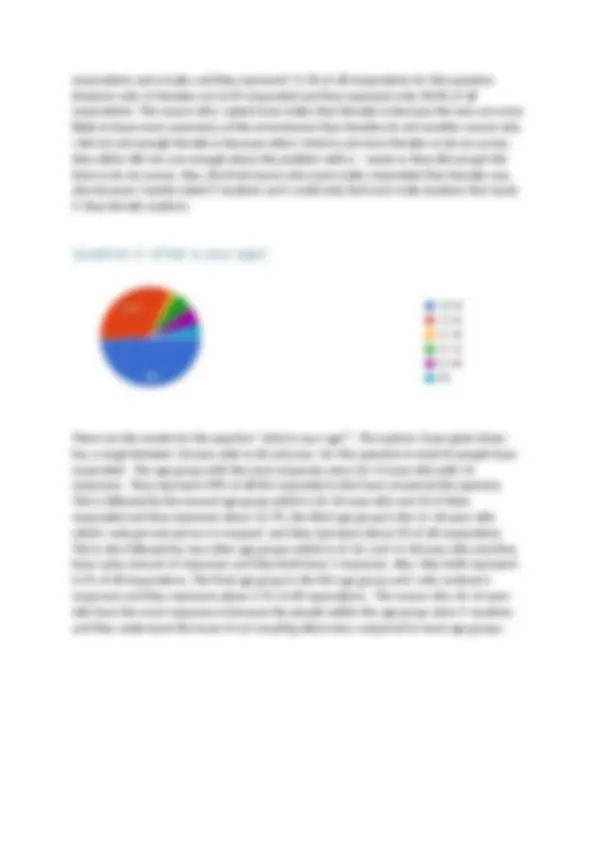
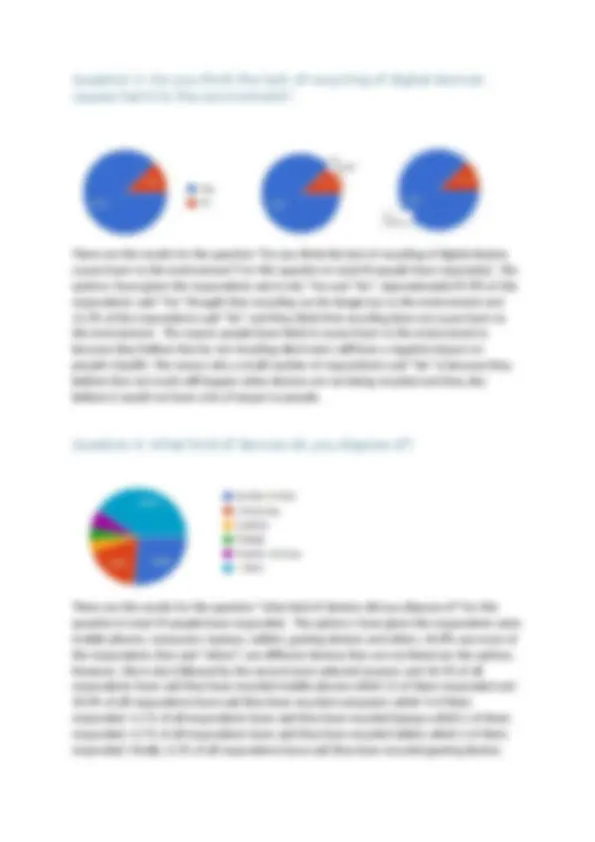
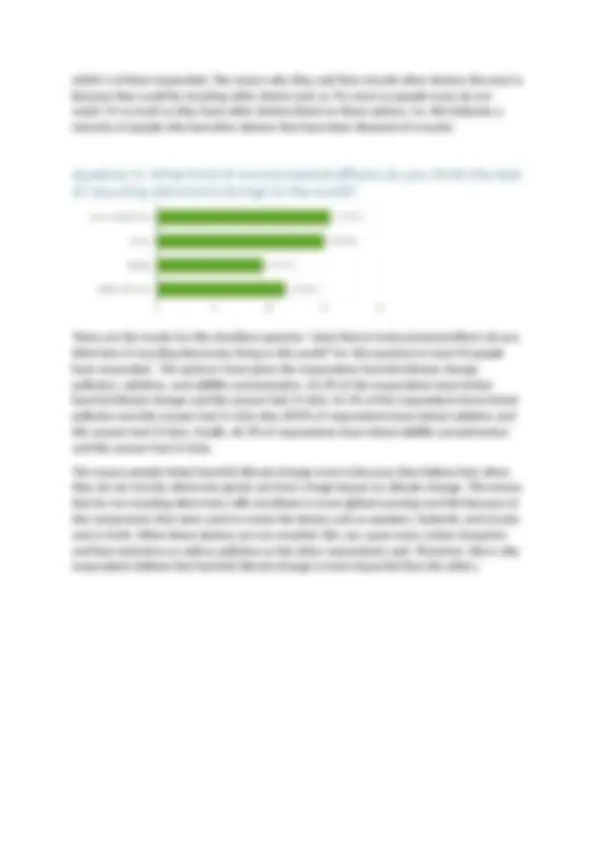
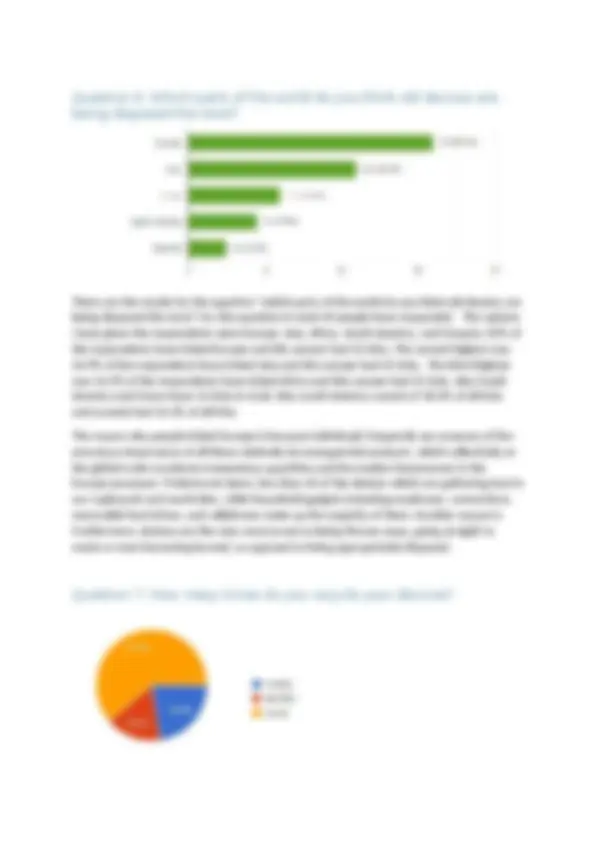
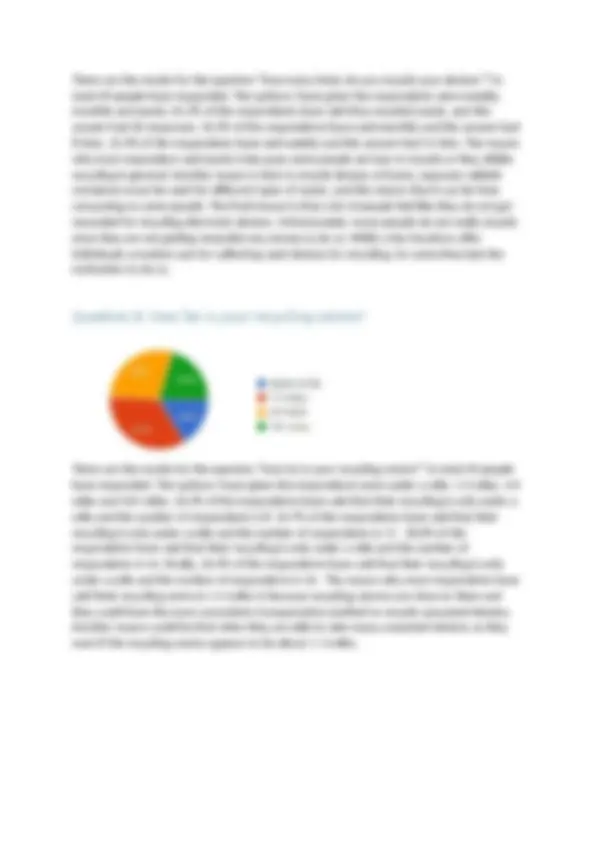
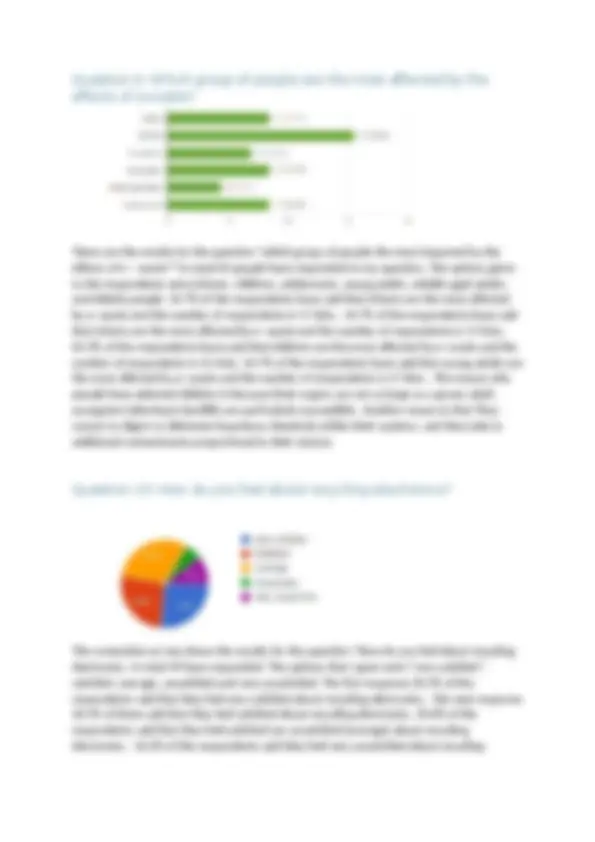



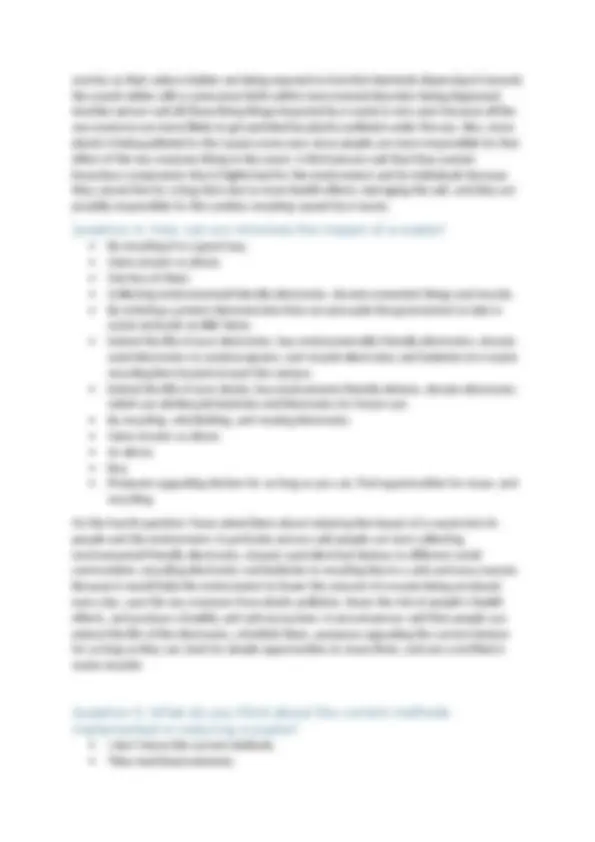
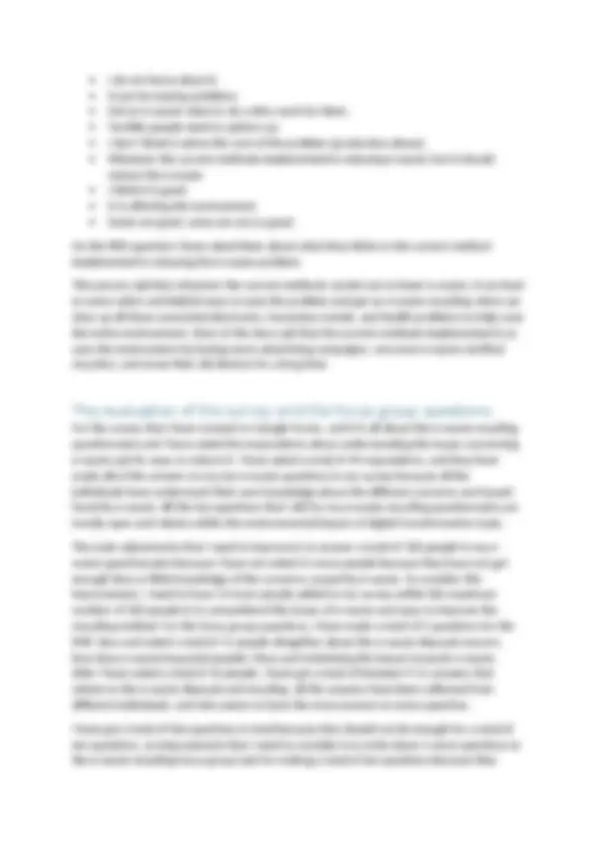

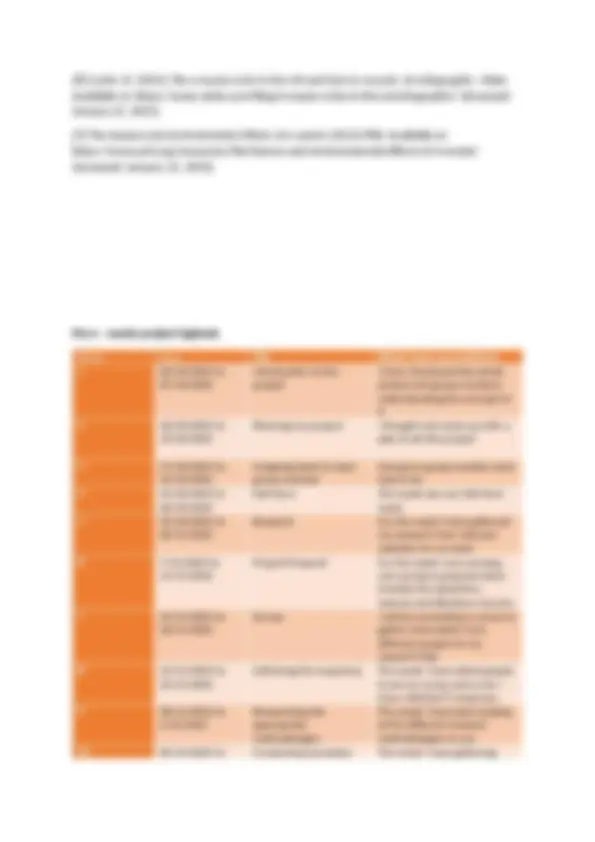
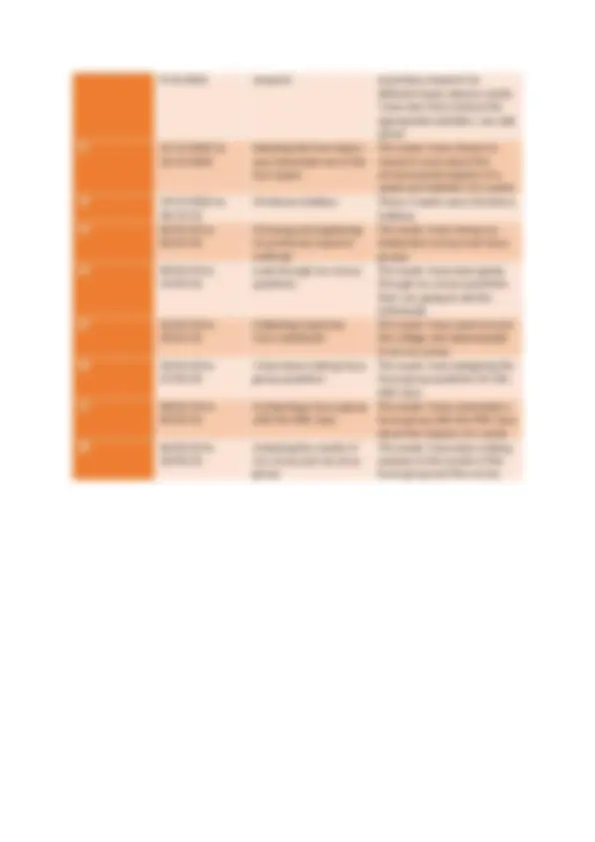


Study with the several resources on Docsity

Earn points by helping other students or get them with a premium plan


Prepare for your exams
Study with the several resources on Docsity

Earn points to download
Earn points by helping other students or get them with a premium plan
Community
Ask the community for help and clear up your study doubts
Discover the best universities in your country according to Docsity users
Free resources
Download our free guides on studying techniques, anxiety management strategies, and thesis advice from Docsity tutors
this talks about the project proposal literature review and survey and focus group analysis
Typology: Cheat Sheet
1 / 33

This page cannot be seen from the preview
Don't miss anything!


























ROBPC | [Company address]
Question 5: What kind of environmental effects do you think the lack of recycling electronics brings to the world?......................................................................................................................... 21 Question 6: Which parts of the world do you think old devices are being disposed the most?...... 22 Question 7: How many times do you recycle your devices?............................................................ 22 Question 8: How far is your recycling centre?................................................................................. 23 ......................................................................................................................................................... 23 Question 9: Which group of people are the most affected by the effects of e-waste?.................... 24 Question 10: How do you feel about recycling electronics? ........................................................... 24 Focus group analysis............................................................................................................................ 25 Question 1: How does e-waste affect everyday life?....................................................................... 25 Question 2: What do you think about e-waste damaging the environment?.................................. 26 Question 3: How do you feel about living things impacted by e-waste?......................................... 27 Question 4: How can we minimise the impact of e-waste?............................................................. 28 Question 5: What do you think about the current methods implemented in reducing e-waste?... 28 The evaluation of the survey and the focus group questions.......................................................... 29 References....................................................................................................................................... 30
For this assignment I will be doing my background research on environmental implications. For example, I will be talking about the environmental risks as well as methods to dispose e waste. Also, I am going to be conducting the different research methods as well. Also, I am going to identify the different research methodologies and discuss the ones I am going to use. UNIT13 - Research Proposal Form Student name: Abdulaahi Khaliif Ali Student number: 40111526 Centre name: Harrow College Date: 10/11/ Tutor: Mohammed Miah Unit: 13 Theme: The environmental impact of digital transformation Section One: Title, objective, responsibilities My title for the project : Environmental impact of E- waste.
The main objective for this project to have look into reducing the environmental effects of e waste. Section Two: Reasons for choosing this research project. I want to research this topic because I would need to have a good understanding of how the world can be affected by e waste. With this research, I can come up with solutions on reducing the environmental risks of e waste and I am able to execute these ideas to reduce the environmental risks. Another reason I want to choose this topic since I would need to consider various methods to disposing old technology to counter e waste. There always solutions to problems which means that e waste can be tackled by means of researching many ways of reducing e waste such as recycling and reusing. Therefore, by researching these topics, the environment will be able to be safe for many living things with less unwanted technology wasted. Section Three: Literature sources searched. [1] Green Journal. (2020). The Negative Effects of E-Waste on Human Health. [Online]. Green Journal. Available at: https://www.greenjournal.co.uk/2020/06/the-negative-effects- of-e-waste-on-human-health/#:~:text=Envi [Accessed 12 November 2022]. I have used this reference to research the risks that e waste can cause, and this has helped me to understand further about the different environmental risks of this issue. The reason I have used this website is because it not only explains what happens, it also gives depth on why this is bad for other people. [2] Green clean guide. (2017). 5 WAYS TO SAFELY DISPOSE OF YOUR ELECTRONIC WASTE. [Online]. Green clean guide. Available at: https://greencleanguide.com/5-ways-to-safely- dispose-of-your-electronic-waste/ [Accessed 21 November 2022]. I have used reference [2] to research the 5 different methods people can safely dispose. This has assisted me with understand that there are many methods people can use to get rid of old electronics that they do not need. The reason I have used this website is that this gives people advice on why you should not throw electronics in the bin, and it also goes into detail on people should manage electronics they do not need. [3] RF Wireless world. (2022). Electronic Waste | E-Waste management | E-waste recycling and disposal. [Online]. RF Wireless world. Available at: https://www.rfwireless-world.com/Articles/E-Waste-management-recycling-and- disposal.html [Accessed 14 December 2022]. I have used reference [3] to do research on e-waste management and this explains the e waste recycling procedure. This website has helped me understand that e waste can be recycled in many like acid being removed from various metals. I find this website useful because it includes the advantages and disadvantages as e waste recycling is not perfect as this would have an impact on living things. the website also explains the advantages concisely for me to understand how it can benefit people and they also explain the disadvantages. Section Four: Activities and timescales
Different Research Methodologies
This is the approach that allows experts to gather information on their own, as opposed to relying on information from earlier studies. They "possess" the information in theory. Primary research is only done to solve a specific issue that needs detailed investigation. It is essential to learn how to utilise primary research because it can considerably enhance your investigation in secondary information, including newspapers, brochures, or publications. Types of businesses can do primary research independently or hire a supplier to do it on their behalf. One important feature of primary research is that it is "targeted," meaning that it is centred on a single topic or problem and all efforts are geared at obtaining relevant answers. For example, a company is preparing to release a new type of smartphone and wants to perform research on the appearance and functions of the phone. Companies can perform primary research using a selected sample of participants who closely match the general population. Based on this data, the brand may now consider possible options for making appropriate changes to the appearance and functions of the smartphone. Each research project has a goal in mind. Companies or enterprises do primary research to keep current on market circumstances and consumer opinion. Great customer satisfaction has emerged as a significant purpose and ambition for many businesses.
A study technique known as secondary information makes use of information which has previously been collected. To improve the whole efficiency of research, current information is gathered and summarised. It can be obtained through websites, archives, and exhibitions and takes a variety of forms, including released statistics, articles, and questionnaire results. Analysts gather, examine, evaluate, as well as integrating secondary information to support the confirmation of their research objectives for the study duration. The information is typically free — or obtainable at a low cost — and is acquired through questionnaires, telephone surveys, observations, face-to-face discussions, and other methods. In addition to the foregoing, it may be used to evaluate past research on a topic of particular interest. Researchers might look for patterns in longitudinal data numerous years to discover tendencies, or they can use it to validate initial hypothesis assertions and determine whether it's worthwhile to continue study into a potential topic.
Once they have all the information in a single place, users must effectively comprehend, filter, arrange, and integrate it. Content may arrive in many forms, some of which may be useless, while others might have to be discarded.
Secondary research resources are divided into two categories both internal and external. Internal data is information collected within the researcher's organisation. External data is information that has been released outside of the researcher's organisation and is not held by the researcher.
Because companies might already have necessary details saved in their systems, internal data is a useful first point of call for perspectives and expertise. Because users control these material and other investigators will not have access to it, it might provide you with a competitive advantage. Internal data instances tend to involve: Transaction records and business objective conversions are stored in a database. Client-generated information about item and service productivity and use via internet apps and handheld site data. Previous research findings or further research topics Previous campaign outcomes
External research is critical when professionals contain data on a different subject, wish to cover gaps in the knowledge, or would like information that disintegrates a demographic or industry for tendency and pattern recognition. External data samples tend to involve: Figures from the administration, non-governmental organisations, and trade associations Publications and studies from the enterprise Competitor analysis Listings of public libraries Reference books and scientific journals Newspaper articles on the media Periodicals and research websites are available online.
To better comprehend ideas, attitudes, or encounters, qualitative research entails gathering and interpreting non-numerical information, and this can be text, video, and audio. It can utilize to uncover intricate details about a situation or to spark fresh study concepts.
focus group are critical to their assessment. Spend some time crafting them, paying close attention to the terminology. Avoid asking leading questions, which might influence the replies. The general focus group questions must be: Open-ended and adaptable Difficult to respond with 'yes' or 'no' (questions beginning with 'why' or 'how' are frequently the best) Straightforward, going right to the point but still sparking debate. Free of bias and impartial
These are research techniques designed to gather feedback through a designated sample of participants to learn more and acquire views into a range of interesting subjects. According to the approach selected and the objective of the investigation, they may be conducted in a variety of methods and serve a variety of objectives. To prevent skewed perspectives that can affect the results of the investigation or analysis, the information is frequently collected using standardised techniques that guarantee that every responder can complete the inquiries anywhere. Surveys are main research instruments that collect data as a component of a larger research strategy. Survey research is essential for obtaining the information needed to make educated decisions about anything from product innovation to marketing initiatives.
Surveys are relatively simple to administer, especially online. If you use the Online survey tool, you will have a variety of configurable themes that will make it simple to customise the survey research. Our data dashboard converts the data into tables and diagrams, making it simple to comprehend and apply. Conducting your survey research online is likely the most cost-effective way to gather data. In-person surveys and interviews require trained staff to gather, calculate, and analyse data. Surveys may be simply modified to capture either quantitative or qualitative information. To get all the knowledge they want, use a range of question styles such as answer options, 7-point Likert, navigation bars, ranked, open-ended, and more.
Due to the confidentiality of online polls, survey respondents may believe they do not have to offer genuine answers. Participants may opt not to answer some questions, resulting in partiality in their results. Participants may have difficulties comprehending and responding when questions and responses are not precise enough. The yes or no question, for instance, may be challenging for an individual who wishes to answer, "just once."
This research technique called an interview focuses on answering queries to gather information. multiple individuals, including interviewers that asks the inquiries, are present during interviewing. Therefore, the main goal of interviews is to learn more about the ideas, practices, and beliefs of the target audience. They typically have greater responses and produce more trustworthy outcomes as opposed to other main research techniques.The company performs research interviews to broaden the scope of its qualitative research methodologies. This might help to consolidate the findings and uncover trends discovered in the industry's quantitative research. Users will examine every interviewee's answer to discover whether there is a pattern of answers. Ultimately, the insights will assist the organisation in making decisions for the future. A structured interview is the initial sort of interview used in research. These are closed- ended questions that appear in a certain order. Participants are asked to reply yes, no, or provide a brief remark. They may occasionally pick from a pre-selected set of replies. Structured interviews are appropriate for both exploratory and informative investigations. Their "uniformity" enables the researcher to identify important trends in customer behaviour. A structured interview makes life easier since the topics only need to be developed once and then reused in several interviews. The tight framework, on the other hand, may inhibit improvisation and in-depth reactions.
The definition of an authoritative research or authoritative research is a collection of data that validity is generally accepted by professionals in the subject or business. There are different types of authoritative research. One of them is recognised and this means that incorporate writings from reliable sources, reputable organisations, and subject-matter authorities. Webpages from educational institutions or the government may fall under this category. Another one is scholarly, and These are preserved in scholarly archives that are also open to the public, including JSTOR, Google Scholar, or Web of science. These publications normally go through reviews by certified academics and subject-matter experts before being released. The final is sources that are revised by associates and the trustworthiness of articles might differ tremendously. Popular, reputable media outlets like The NY Times, The Wall Street Journal, and Bloomberg are examples of trustworthy news sources.
Although not regarded as the system of records for data about the identification themselves, non-authoritative publications may include certain correct information about individuals. This type of research will enable users to look for information that is already been published by authors and it also displays their general beliefs on the topic, but it does
Allow oneself to create them a vision. You've gotten rid of your old one since buying a new one. It is currently buried in a landfill. The sun's heat begins to melt, break, and deform the circuitry. This permits all the hazardous compounds to permeate and contaminate the soil. Toxins are transferred from the topsoil to freshwater resources, putting crops at danger. Before being plucked, marketed, and consumed by the public, the crops leak harmful residues of e-waste. Have they ever considered what goes into making the laptop you're working on, the smartphone in the hand, or the notebook you've put on a stand? There are several of them. The simplest and most straightforward solution to your e-waste situation is to get your equipment fixed rather than simply tossing it and acquiring something new. If you have a battery problem, a broken screen, or a charging issue, these are simple repairs that only an expert can do.The second alternative is to purchase reconditioned old devices rather than brand new equipment. This not only costs you less on the transaction, but it also helps to keep the recycling cycle going. This has the potential to have a big environmental impact. Recycling procedures in the informal sector amplify health hazards. For instance, primary and secondary contamination to harmful metals like lead is mostly caused by combustion used to recover precious components like gold. The combustion of e-waste produces tiny particulate matter, which has been related to respiratory and cardiovascular problems. While the health consequences of e-waste are difficult to identify due to informal working circumstances, poverty, and inadequate sanitation, many studies in Guiyu, a city in southern China, provide some insight. Guiyu is regarded as the world's largest e-waste recycling facility, and the city's population suffer from significant digestive, neurological, pulmonary, and bone ailments. 80 percent of Guiyu's youngsters have respiratory problems and are incredibly susceptible to heavy metal poisoning.
Billy (2018) states that one advantage of recycling is that it can retain natural resources. Most natural elements are non-renewable in the environment. The essential materials can be simply removed and enabled to retrieve using e-waste disposal. This enables the manufacturing of additional goods using the same materials. This permit lowering emissions, conserving resources, as well as conserving energy. Another advantage of recycling is that states that Prajakta Bhujbal (2022) is that assists with restoring the most important materials from devices. Natural materials are saved and conserved in this way. Therefore, companies may simply recycle and repurpose the elements of e-waste rather than having to extract the materials.
Recovering e-waste is not only helpful for the environment, but it can also help a company's financial line. Several national authorities have now incentivized e-waste recycling by raising dumping fees or outright prohibiting it. There are also some intangible benefits of recycling to contemplate, including decreased future expenses of non-renewable resources and increased employee morale and retention. Because of the increasing demand for electronic products and appliances, a variety of metallic materials as well as other non-renewable commodities must be extracted and handled. Several of the materials used to create cell phones, refrigerators, and other e- waste, on the other hand, may be repurposed. Steel, aluminium, copper, and gold are among these resources, as are vast quantities of plastics that may be recycled into new items. Disposing e-waste reuses these materials once you've finished with your item, but dumping e-waste in a landfill requires additional supplies to be dug up to create your next notebook or television set. Employees are more interested in working for companies that take care of the environment as well as the communities. Disposal is an easy and concrete approach for your organisation to demonstrate its dedication to ethical and environmental standards, as well as to promote those concepts with their staff. Recycling e waste can have some disadvantages such as Human health risks from improperly disposal of e-waste, the biggest disadvantage is that it has a significant impact on the cognitive and reproduction organs of humans, which can result in illness and birth problems. It is crucial to raise attention about the hazard posed by inadequate e-waste recycling because it poses an incredibly serious risk to the ecosystem worldwide. Another disadvantage is that the disposal of electronic waste on sites carries a certain degree of danger. Harmful compounds have caused this because of their dissolving and vaporization. This is because despite the reality that several nations increasingly appreciate e-waste recycling regulations, issues and concerns still exist. There is a tiny proportion of the world's digital rubbish, that includes either laptop or gadgets, is recovered now. Several ecological dangers are increased as a result.
Approximately 2.37 million tonnes of old televisions, desktop computers, electronics such as photocopiers, scanners, and fax, mouse, keypad, and mobile phones were dumped back in 2009. It also makes for 2% of the waste dumped in disposal sites in America, yet it accounts for 70 percent of all harmful waste. This means that e waste does not represent most of the waste, but they are represented as being the most harmful. Another statistic of e waste is that Annually, under 50 million metric tonnes of e-waste are rid of globally. Because 82.6% of electronic trash is not disposed (through formal means), it is not reported. Researchers are unable to determine in which it tends to end up. It is projected approximately 8% of e-waste is tossed in the garbage, where it eventually ends up in a landfill or is burnt. This is largely made up of tiny electrical and IT devices (tablets, mobile phones etc). It is projected that up to 20% will be transported, whether as refurbished
waste recyclers, NGOs, colleges, manufacturers, or anyone else. Otherwise, there is a risk that data kept on hard drives will get into the hands of the wrong people. There's an ancient adage "one man's trash is another man's treasure" users may have thought of it. If you use this statement here, it may make it easier to dispose of your e trash. You may swap them for gift vouchers on websites such as Amazon. Some local businesses also offer trade-in programmes. Before acquiring a new item, inquire whether the retailer would purchase back your old laptop or camera. Best Buy, like Apple, has a trade-in programme in which it exchanges gift cards for obsolete IT equipment. IT disposal firms are the ideal drop-off places for e-waste disposal. Most firms will even take up your garbage goods from your door; all users need to do is phone them. Some computer recycling businesses operate locally, while others operate on a national scale. Employing the services of competent e trash recycling companies will also aid in the management of environmental pollution, since most harmful materials contained within such gadgets cannot be adequately handled at landfills and risk ending up polluting the soil. Donation is without a doubt one of the greatest methods to dispose of gadgets. However, if you intend to donate your device to a higher education institution, you must ensure that it is still operational. Even if they don't, there are plenty of charity that will gladly take them off their hands.
I have selected to talk about Environmental risks and the ways to dispose e waste. Firstly, I am interested in talking about the environmental problems because I have found that there is convenient way on how to safely dispose old electronics and these methods will help reduce electronics reduce in landfills and protect to the environment more. I am also interested in talking about the statistics of e waste because I can know how much e waste is being dumped and the number of people it affects. Another reason is that I can know how e-waste also affects different countries.
For this section this is where I am going to be analysing the results for my survey. Also, I will be talking about the amount of responses I have for each question. There were 49 respondents to my e-waste disposal survey when they had completed questions, however I will include an explanation about how I had acquired the data. Question No. Question Answer Reason for choosing this question
1 What is your gender? I chose to ask what gender they are n because I wanted to know which gender would get the most responses. 2 what is your age? I chose to ask their question because I wanted to know the different ages of each respondent and the different opinions of these age groups. 3 Do you think the lack of recycling of digital devices causes harm to the environment? I wanted to ask about the lack of recycling because I felt that there is not enough recycling in this world, and I wanted to know what if people think that insufficient recycling will affect the environment. 4 What kind of devices do you dispose of? I am going to ask the type of devices they get rid of because I wanted to know the different the devices they do not use and dispose of.
9 Which group of people are the most affected by the effects of e-waste? I would like to ask this question because I wanted to know which group of people is most likely going to be affected by e – waste. 10 How do you feel about recycling electronics? I want to ask this question because I wanted to know people’s overall opinion how they feel about recycling and if they feel that the recycling is effective or not effective.
There are the results for the question “what is your gender?”. The options I have given them were males and female. For this question in total 49 people have responded. 35 out of 49
respondents were males and they represent 71.4% of all respondents for this question. However only 14 females out of 49 responded and they represent only 28.6% of all respondents. The reason why I asked more males than females is because the men are more likely to have more awareness of the environment than females do and another reason why I did not ask enough females is because when I tried to ask more females to do my survey, they either did not care enough about the problem with e – waste or they did not get the time to do my survey. Also, the final reason why more males responded than females was also because I mainly asked IT students and I could only find more male students that study IT than female students.
There are the results for the question “what is your age?”. The options I have given them has a range between 16 years olds to 60 and over. For this question in total 49 people have responded. The age group with the most responses were 16–19-year-olds with 24 responses. They represent 49% of all the respondents that have answered the question. This is followed by the second age group which is 20–30-year-olds and 16 of them responded and they represent about 32.7%. the third age group is the 31–40-year-olds which I only got one person to respond, and they represent about 2% of all respondents. This is also followed by two other age groups which is 41-50- and 51–60-year-olds and they have same amount of responses and they both have 3 responses. Also, they both represent 6.1% of all respondents. The final age group is the 60+ age group and I only received 2 responses and they represent about 4.1% of all respondents. The reason why 16–19-year- olds have the most responses is because the people within the age group were IT students and they understand the issue of not recycling electronics compared to most age groups.